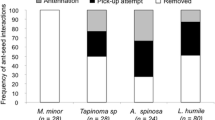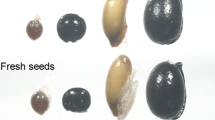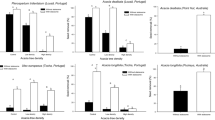Abstract
Seed dispersal may involve different vectors of dispersal in two or more sequential phases (i.e., diplochory). However, contributions of each phase to the overall seed dispersal effectiveness (SDE) are poorly understood and hard to evaluate due to post-dispersal processes that affect seed and seedling survival. We investigated the simultaneous bird (phase 1, in plant canopy) and ant (phase 2, on the floor) contributions to SDE with the ornithochoric shrub Erythroxylum ambiguum in a Brazilian Atlantic forest. Twelve species of birds fed on fruit and dispersed approximately 26 % of the seed crop. The remaining seed crop, 90 % of which contained viable seeds, fell to the ground beneath the parental plant. Ants either cleaned seeds in fruits or carried fallen fruit and seeds from bird feces to their nests. Although E. ambiguum has no adaptation for ant dispersal, ants were as quantitatively important as birds. Birds and ants equally increased germination rates compared to controls. However, birds deposited seeds farther from the parent, where seedling survival was higher (78 %) than it was beneath the parent (44 %), whereas ants carried seeds to their nests, where seedling survival was higher (83 %) than in controls away from their nests (63 %). Diplochory allowed a 42 % increase in SDE compared to dispersal in phase 1 alone. High lipid content in the fruit pulp of E. ambiguum may facilitate the inclusion of ants in a second step of dispersal after diaspores reach the floor. Ants can also buffer the dispersal of diplochorous plants against decreases in phase 1 dispersers.




Similar content being viewed by others
References
Andersen E, Feer F (2005) The role of dung beetles as secondary seed dispersers and their effect on plant regeneration in tropical rainforests. In: Forget PM, Lambert J, Hulme P, Vander Wall S (eds) Seed fate: predation, dispersal and seedling establishment. CABI International, Wallingford, pp 331–349
Bieber AGD, Silva PSD, Oliveira PS (2013) Attractiveness of fallen fleshy fruits to ants depends on previous handling by frugivores. Écoscience 20:85–89. doi:10.2980/20-1-3573
Böhning-Gaese K, Gaese BH, Rabemanantsoa SB (1999) Importance of primary and secondary seed dispersal in the Malagasy tree Commiphora guillaumini. Ecology 80:821–832. doi:10.1890/0012-9658(1999)080[0821:IOPASS]2.0.CO;2
Bottcher C, Oliveira PS (2014) Consumption of lipid-rich seed arils improves larval development in a Neotropical primarily carnivorous ant, Odontomachus chelifer (Ponerinae). J Trop Ecol 30:621–624. doi:10.1017/S0266467414000479
Briggs JS, Vander Wall SB, Jenkins SH (2009) Forest rodents provide directed dispersal of Jeffrey pine seeds. Ecology 90:675–687. doi:10.1890/07-0542.1
Calviño-Cancela M, Martín-Herrero J (2009) Effectiveness of a varied assemblage of seed dispersers of a fleshy-fruited plant. Ecology 90:3503–3515. doi:10.1890/08-1629.1
Christianini AV, Oliveira PS (2009) The relevance of ants as seed rescuers of a primarily bird-dispersed tree in Neotropical cerrado savanna. Oecologia 160:735–745. doi:10.1007/s00442-009-1349-2
Christianini AV, Oliveira PS (2010) Birds and ants provide complementary seed dispersal in a Neotropical savanna. J Ecol 98:573–582. doi:10.1111/j.1365-2745.2010.01653.x
Christianini AV, Mayhé-Nunes AJ, Oliveira PS (2012) Exploitation of fallen diaspores by ants: are there ant–plant partner choices? Biotropica 44:360–367. doi:10.1111/j.1744-7429.2011.00822.x
Christianini AV, Oliveira PS, Bruna EM, Vasconcelos HL (2014) Fauna in decline: meek shall inherit. Science 345:1129. doi:10.1126/science.345.6201.1129-a
Clark CJ, Poulsen JR, Levey DJ, Osenberg CW (2007) Are plant populations seed limited? A critique and meta-analysis of seed addition experiments. Am Nat 170:128–142. doi:10.1086/518565
Colodel EM, Seitz AL, Schmitz M, Borba MR, Raymundo DL, Driemeier D (2004) Intoxicação por Eryhtroxylum deciduum (Erythroxylaceae) em ovinos. Pesq Vet Bras 24:165–168. doi:10.1590/S0100-736X2004000300009
Connell JH (1971) On the role of natural enemies in preventing competitive exclusion in some marine animal and in rainforest trees. In: Den Boen PJ, Gradwell PR (eds) Dynamics of populations. Pudoc, Wageningen, pp 298–312
Culot L, Huynen MC, Heymann EW (2015) Partitioning the relative contribution of one-phase and two-phase seed dispersal when evaluating seed dispersal effectiveness. Methods Ecol Evol 6:178–186. doi:10.1111/2041-210X.12317
Dirzo R, Young HS, Galetti M, Ceballos G, Isaac NJB, Collen B (2014) Defaunation in the Anthropocene. Science 345:401–406. doi:10.1126/science.1251817
Fedriani JM, Delibes M (2013) Pulp feeders alter plant interactions with subsequent animal associates. J Ecol 101:1581–1588. doi:10.1111/1365-2745.12146
Forget PM, Lambert JE, Hulme PE, Vander Wall SB (2004) Seed fate: predation, dispersal and seedling establishment. CABI International, Wallingford
Fundação Florestal (2008) Parque Estadual Carlos Botelho: Plano de manejo. Fundação Florestal, São Paulo
Giladi I (2006) Choosing benefits or partners: a review of the evidence for the evolution of myrmecochory. Oikos 112:481–492. doi:10.1111/j.0030-1299.2006.14258.x
González-Castro A, Calviño-Cancela M, Nogales M (2015) Comparing seed dispersal effectiveness by frugivores at community level. Ecology 96:808–818. doi:10.1890/14-0655.1
Gotelli NJ, Ellison AM (2011) Princípios de estatística em ecologia. Artmed, Porto Alegre
Gove AD, Majer JD, Dunn RR (2007) A keystone ant species promotes seed dispersal in “diffuse” mutualism. Oecologia 153:687–697. doi:10.1007/s00442-007-0756-5
Hampe A (2004) Extensive hydrocory uncouples spatiotemporal patterns of seedfall and seedling recruitment in a ‘bird-dispersed’ riparian tree. J Ecol 92:797–807. doi:10.1111/j.0022-0477.2004.00918.x
Hölldobler B, Wilson EO (1990) The ants. Harvard University Press, Cambridge
Howe HF, Smallwood J (1982) Ecology of seed dispersal. Annu Rev Ecol Syst 13:201–228. doi:10.1146/annurev.es.13.110182.001221
Janzen DH (1970) Herbivores and the number of trees species in tropical forests. Am Nat 104:501–528. doi:10.1086/282687
Jordano P (2000) Fruits and Frugivory. In: Fenner M (ed) Seeds: the ecology of regeneration in plant communities. CABI International, Wallingford, pp 125–166
Jordano P, Schupp EW (2000) Seed disperser effectiveness: the quantity component and patterns of seed rain for Prunus mahaleb. Ecol Monogr 70:591–615. doi:10.1890/0012-9615(2000)070[0591:SDETQC]2.0.CO;2
Jordano P, García C, Godoy JA, García-Castaño JL (2007) Differential contribution of frugivores to complex seed dispersal patterns. Proc Natl Acad Sci USA 104:3278–3282. doi:10.1073/pnas.0606793104
Leal LC, Lima Neto MC, Oliveira AFM, Andersen AN, Leal IR (2014) Myrmecochores can target high-quality disperser ants: variation in elaiosome traits and ant preferences for myrmecochorous Euphorbiaceae in Brazilian Caatinga. Oecologia 174:493–500. doi:10.1007/s00442-013-2789-2
Lengyel S, Gove AD, Latimer AM, Majer JD, Dunn RR (2009) Ants sow the seeds of global diversification in flowering plants. PLoS One 4:e5480. doi:10.1371/journal.pone.0005480
Lima RAF, Dittrich VAO, Souza VC, Salino A, Breier TB, Aguiar OT (2011) Flora vascular do Parque Estadual Carlos Botelho, São Paulo, Brasil. Biota Neotrop 11:173–214. doi:10.1590/S1676-06032011000400018
Lomáscolo SB, Levey DJ, Kimball RT, Bolker BM, Alborn HT (2010) Dispersers shape fruit diversity in Ficus (Moraceae). Proc Natl Acad Sci USA 107:14668–14672. doi:10.1073/pnas.1008773107
Moles AT, Westoby M (2004) What do seedlings die from and what are the implications for the evolution of seed size? Oikos 106:193–199. doi:10.1111/j.0030-1299.2004.13101.x
Nathan R (2006) Long-distance dispersal of plants. Science 313:786–788. doi:10.1126/science.1124975
Ohkawara K, Akino R (2005) Seed cleaning behavior by tropical ants and its anti-fungal effect. J Ethol 23:93–98. doi:10.1007/s10164-004-0132-4
Passos L, Oliveira PS (2002) Ants affect the distribution and performance of seedlings of Clusia criuva, a primarily bird-dispersed rain forest tree. J Ecol 90:517–528. doi:10.1046/j.1365-2745.2002.00687.x
Passos L, Oliveira PS (2004) Interaction between ants and fruits of Guapira opposita (Nyctaginaceae) in a Brazilian sandy plain rainforest: ant effects on seeds and seedlings. Oecologia 139:376–382. doi:10.1007/s00442-004-1531-5
Pérez-Ramos IM, Verdú JR, Numa C, Marañón T, Lobo JM (2013) The comparative effectiveness of rodents and dung beetles as local seed dispersers in Mediterranean oak forests. PLoS One 8:e77197. doi:10.1371/journal.pone.0077197
Pizo MA, Oliveira PS (2001) Size and lipid content of nonmyrmecochorous diaspores: effects on the interaction with litter-foraging ants in the Atlantic rain forest of Brazil. Plant Ecol 157:37–52. doi:10.1023/A:1013735305100
Pyke DA, Thompson JN (1986) Statistical analysis of survival and removal rate experiments. Ecology 67:240–245. doi:10.2307/1938523
R Development Core Team (2013) R: a language and environment for statistical computing. R Foundation for statistical computing, Vienna. http://www.R-project.org/> Accessed 4 May 2013
Rico-Gray V, Oliveira PS (2007) The ecology and evolution of ant–plant interactions. University of Chicago Press, Chicago
Samuels IA, Levey DJ (2005) Effects of gut passage on seed germination: do experiments answer the questions they ask? Funct Ecol 19:365–368. doi:10.1111/j.1365-2435.2005.00973.x
Schupp EW (1993) Quantity, quality and the effectiveness of seed dispersal by animals. Vegetatio 107(108):15–29. doi:10.1007/BF00052209
Schupp EW, Jordano P, Gómez JM (2010) Seed dispersal effectiveness revisited: a conceptual review. New Phytol 188:333–353. doi:10.1111/j.1469-8137.2010.03402.x
Stiles EW (1993) The influence of pulp lipids on fruit preference by birds. Vegetatio 107/108:227–235. doi:10.1007/BF00052225
Traveset A, Riera N, Mas RE (2001) Passage through bird guts causes interspecific differences in seed germination characteristics. Funct Ecol 15:669–675. doi:10.1046/j.0269-8463.2001.00561.x
Vander Wall SB (2008) On the relative contributions of wind vs. animals to seed dispersal of four sierra Nevada Pines. Ecology 89:1837–1849. doi:10.1890/07-0409.1
Vander Wall SB, Longland WS (2004) Diplochory: are two seed dispersers better than one? Trends Ecol Evol 19:155–161. doi:10.1016/j.tree.2003.12.004
Vander Wall SB, Kuhn KM, Gworek JR (2005) Two-phase seed dispersal: linking the effects of frugivorous birds and seed-caching rodents. Oecologia 145:282–287. doi:10.1007/s00442-005-0125-1
Vieira EM, Pizo MA, Izar P (2003) Fruit and seed exploitation by small rodents of the Brazilian Atlantic forest. Mammalia 67:533–539. doi:10.1515/mamm-2003-0407
Wang BC, Smith TB (2002) Closing the seed dispersal loop. Trends Ecol Evol 17:379–385. doi:10.1016/S0169-5347(02)02541-7
Warren RJ II, Giladi I (2014) Ant-mediated seed dispersal: a few ant species (Hymenoptera: Formicidae) benefit many plants. Myrmecol News 20:129–140
Wenny DG (2001) Advantages of seed dispersal: a re-evaluation of directed dispersal. Evol Ecol Res 3:51–74
Acknowledgments
This article is part of the thesis of P. H. S. A. C. funded by the Conselho Nacional de Pesquisa (CNPq 478938/2011-0) and Coordenação de Aperfeiçoamento de Pessoal de Nível Superior. We thank M. A. Pizo and A. J. Piratelli for criticism. Comments from E. W. Schupp and an anonymous referee helped us to improve the manuscript. We thank S. M. Rodrigues and A. J. Piratelli for sharing data on bird frugivory, F. F. M. Capelo for plant identification, A. J. Raszl for chemical analysis, and R. F. Mantezi, A. S. F. Silva and the Zoológico Municipal de Sorocaba for the facilities to perform the bird feeding trials. We thank the Fundação Florestal de São Paulo and the staff of CBSP for the research license and logistic support. We are grateful to B. J. Lopes, D. J. Moreno, J. P. Line, J. Lima, L. M. S. A. Camargo, S. Z. T. Amancio and V. M. Silva for help during fieldwork.
Author contribution statement
A. V. C., M. M. M. and P. H. S. A. C. designed the experiments. P. H. S. A. C. performed the experiments. R. M. F. identified the ants. P. H. S. A. C. and A. V. C. analyzed the data. A. V. C., P. H. S. A. C., M. M. M. and R. M. F. wrote the manuscript.
Author information
Authors and Affiliations
Corresponding author
Ethics declarations
Conflict of interest
The authors declare that they have no conflict of interest.
Statement of human and animal rights
All applicable institutional and/or national guidelines for the care and use of animals were followed.
Additional information
Communicated by Moshe Inbar.
Rights and permissions
About this article
Cite this article
Camargo, P.H.S.A., Martins, M.M., Feitosa, R.M. et al. Bird and ant synergy increases the seed dispersal effectiveness of an ornithochoric shrub. Oecologia 181, 507–518 (2016). https://doi.org/10.1007/s00442-016-3571-z
Received:
Accepted:
Published:
Issue Date:
DOI: https://doi.org/10.1007/s00442-016-3571-z




